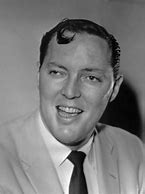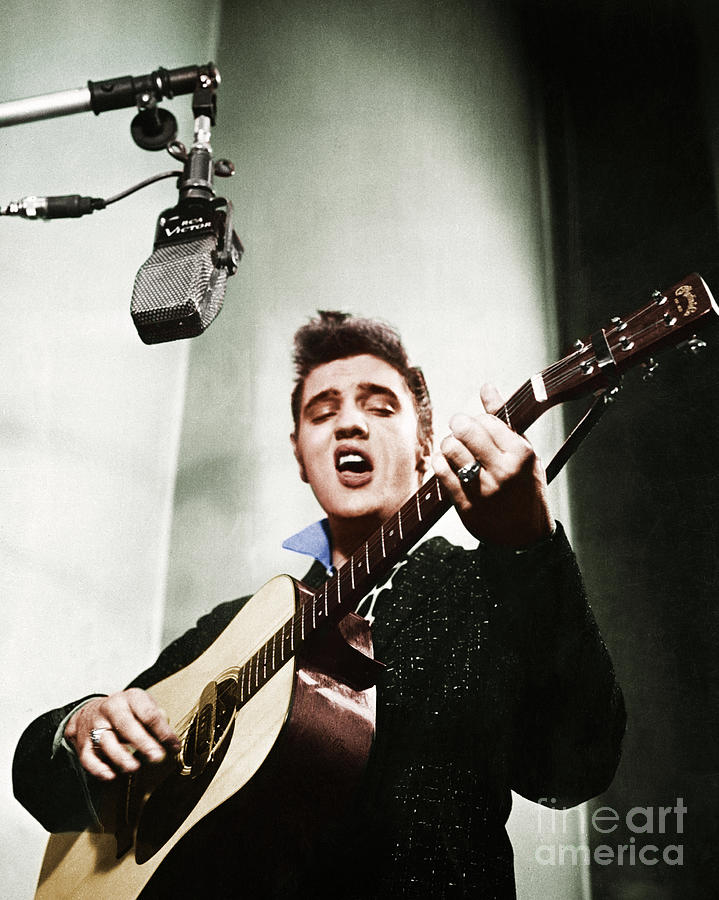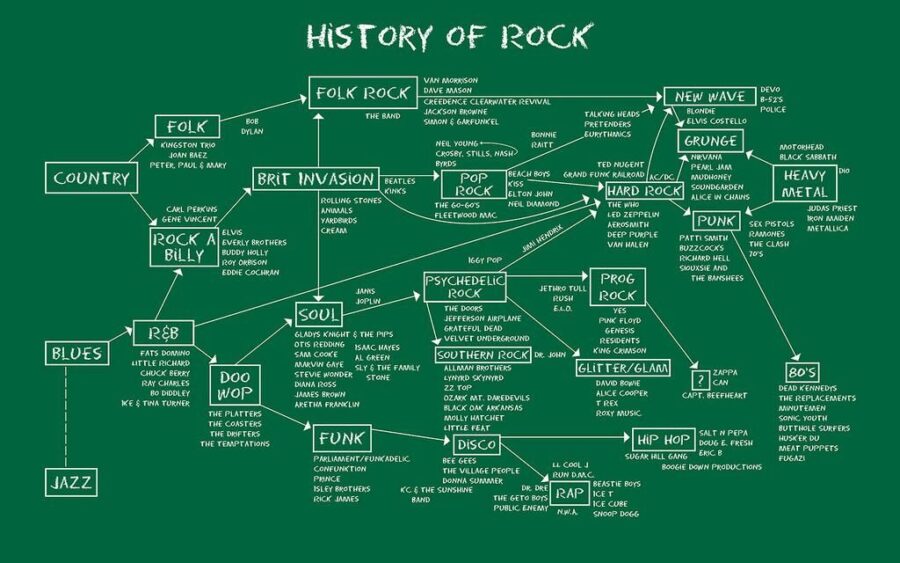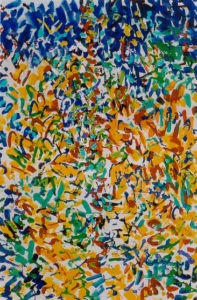How Rock ‘n’ Roll Began

The movie that called America’s attention to rock ‘n’ roll is about teenage rebellion. “Rock Around the Clock” is the first rock ‘n’ roll song to hit #1 on Billboard’s Hot 100. Source: TeachRock
Rock ‘n’ roll began as an outcome of musical interactions between Black and white. How did it establish a stronghold in the mid-’50s?
A Matter of Opinion
The birth of rock ‘n’ roll didn’t happen overnight. This combustible hybrid of musical genres as varied as rhythm & blues (formerly “race music”), boogie-woogie, the blues, jazz and western swing, gospel, and country/western was a work in progress for much of the 20th century.
By the mid-’50s, it was given a name. That made it easier to talk about and spread the word.
Here is a random sample of opinions about rock ‘n’ roll’s evolution, spoken by people who might have known a thing or two about it:
Skeptical Bandleader
Rock ‘n’ roll was not a marriage of rhythm and blues and country and western. That’s white publicity. Rock ‘n’ roll was just a white imitation, a white adaptation, of Negro rhythm and blues.
—Louis Jordan, multi-instrumentalist, songwriter, and bandleader
Blues Icon
The blues had a baby and they named it rock ‘n’ roll.
—Muddy Waters, famous blues performer who wrote a song with those words
Jazz Great
Rock ‘n’ roll is the most raucous form of jazz, beyond a doubt…I believe that no other form of jazz has ever been enthusiastically accepted by so many.
–Duke Ellington, legendary bandleader and jazz artist
Elvis’s Founding Father
If I could find a white man who had the Negro sound with the Negro feel, I could make a billion dollars…This is what I heard in Elvis, this Negro sound.
–Sam Phillips, owner of Sun Records
Bill Haley and his Comets
The nascent musical form was introduced to many Americans in March 1955 with the release of a major motion picture, The Blackboard Jungle. The plot centered on a schoolteacher beleaguered by adolescent rebellion, and it didn’t take long for the music to be associated with rebellion as well. By summer, The Blackboard Jungle was the hottest movie in America and symbolized the moment when rock ‘n’ roll exploded into the national consciousness.
The movie’s theme song, “Rock Around the Clock,” was played by Bill Haley and his Comets, a Western swing outfit that began incorporating rhythm and blues chords into its repertoire. Haley and his Comets based their song on Big Joe Turner’s “Shake, Rattle and Roll” (which Haley covered…of course).
“Rock Around the Clock,” which was written in the 12-bar blues format, is recognized as the first rock song to top the pop charts. It stayed #1 for two months.
Alan Freed, the Old Moondog
Cleveland disc jockey Alan Freed, whose Moondog radio show was the first to play rock ‘n’ roll exclusively, supposedly coined the term “rock and roll.” From his radio pulpit, Freed was perhaps the most effective proselytizer the genre has ever known.
Freed is credited with staging the first rock ‘n’ roll concert, of which I wrote about here. Freed’s pioneering efforts were enough to put him in the inaugural class (1986) of the Rock and Roll Hall of Fame.
(The other inaugural inductees were Chuck Berry, James Brown, Ray Charles, Sam Cooke, Fats Domino, the Everly Brothers, Buddy Holly, Jerry Lee Lewis, Elvis Presley, Little Richard, Robert Johnson, Jimmie Rodgers, Jimmy Yancey, John Hammond, and Sam Phillips. )
Rocket 88
Here is a superb video that tells the story of “Rocket 88,” a candidate for the first-ever rock ‘n’ roll song, performed by Jackie Brenston and his Delta Cats, with great ’50s photos, Bill Haley and his Comets, Elvis, Little Richard, Ike Turner, and more, published by Nathaniel Jordan via YouTube.
The Roots of Rock ‘n’ Roll
Robert Palmer, the celebrated music journalist who died in 1997 of cancer at the age of 52, wrote a good summary statement for Rolling Stone:
[Rock ‘n’ roll’s] roots are a complex tangle. Bedrock black church music influenced the blues. Rural blues influenced the white folk song and the Black popular music of the Northern ghettos, blues and Black pop influenced jazz, and so on. But the single most important process was the influence of Black music on white. Rock might not have developed out of a self-contained Afro-American tradition, but it certainly would not have developed had there been no Afro-Americans.
From Ballads to Boogie
Meanwhile in Memphis, a young Elvis Presley walked into Sun Studio with aspirations of being a country-pop crooner. His primary source of popular music was country radio. Ever since that fateful day on July 4, 1954, when Elvis first met bandmates guitarist Scotty Moore and bassist Bill Black, Elvis leaned toward “the syrupy and the maudlin.” It took the sturdy influence of Sun Studio’s predominantly Black clientele and the guiding hand of Sam Phillips for Elvis to embrace rhythm and blues.
In 1955, Phillips produced a song for Elvis Presley titled, “Mystery Train,” written by a young Black singer and harmonica player named Herman “Junior” Parker. Phillips also produced the Presley hit, “That’s All Right (Mama),” written in 1946 by Arthur “Big Boy” Crudup, who was the first blues performer to land a record on Billboard’s “Race Records” chart.
In his outstanding book, Before Elvis: The Prehistory of Rock ‘n’ Roll, Larry Birnbaum wrote:
Presley was not the first white person or white southerner to sing rock ‘n’ roll, much less to sing African American music. He became a superstar because he arrived at the right time and place with the look, moves, style, and sttitude that the youthful public was waiting for.
Rock ‘n’ Roll Is Here to Stay
Haley’s “Rock Around the Clock” kicked the door wide open for both Black and white rockers. Between July 1955 and January 1956, rhythm and blues hits such as Fats Domino’s “Ain’t That a Shame,” Little Richard’s “Tutti Frutti,” and Chuck Berry’s “Maybelline” crossed over to the pop charts.
The next year, Elvis’s “Heartbreak Hotel,” the Everly Brothers’ “Bye Bye Love,” the Crickets’ “That’ll Be the Day” (featuring Buddy Holly), Carl Perkins’ “Blue Suede Shoes,” and Jerry Lee Lewis’s “Whole Lotta Shakin’ Going On” followed suit. It was a strong indication that rock ‘n’ roll was here to stay.
The Electric Guitar
The electric guitar is synonymous with rock ‘n’ roll. And there was no finer practitioner than Chuck Berry, whose fast shuffle guitar playing and clever two-minute ditties kicked up a storm in rock ‘n’ roll’s early days. Guitar World:
Chuck Berry is the father of rock ‘n’ roll because of his ability to synthesize various genres of music into a sound that could appeal to teens and adults alike…His licks and mastery of melody drew people from all walks of life, and contributed to what many see as the blueprint for rock ‘n’ roll that would last forever.
The Jazz Connection
During the swing era (1933-47), big bands led by Count Basie, Benny Goodman, and Tommy Dorsey picked up the boogie-woogie (percussive and rhythmic piano playing and a pounding bass) that laid a foundation for rhythm and blues. Swing was a danceable form that was passed down from parents to teenagers.
During that time, jazz and blues musicians began experimenting with the electric guitar. In 1939, Oklahoman Charlie Christian played electric guitar on a Benny Goodman recording. His sound immediately resonated. Christian often performed with an older guitarist, Aaron “T-Bone” Walker, who “invented modern blues guitar, setting the style that almost all subsequent blues and rock guitarists would follow, from B.B. King through Eric Clapton.”
T-Bone Walker
T-Bone Walker harnessed the electricity in his guitar. Robert Palmer once more:
By using his amplifier’s volume control to sustain pitches, and combining this technique with string-bending and finger vibrato…Walker in effect invented a new instrument. He was able to reproduce…the convuluted cry of blues and gospel singers. In addition, he developed a chordal style on fast numbers, a pumping guitar shuffle which eventually led to the archetypal rock ‘n’ roll guitar style of Chuck Berry.
A rock guitar pioneer.
Coda
Here is a somewhat flawed but earnestly exhaustive chart that maps the history of rock ‘n’ roll:
We all had our points of entry. Whether yours was the blues, the Beatles, or heavy metal, it was a time we will always cherish.




















































































































